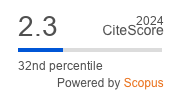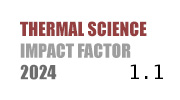THERMAL SCIENCE
International Scientific Journal
Thermal Science - Online First
online first only
Combustion characteristics of dual swirl low nitrogen burners in small gas boilers
ABSTRACT
Swirl combustion technology is an effective method for achieving low-nitrogen (low NOx) combustion. In this study, we designed a dual-swirl low-NOx burner with the goal of minimizing NOx emissions. and the burner was evaluated in a 20t/h gas boiler through numerical simulation and experimentation. Swirl angles and excess air coefficients (1.0 to 1.20) of the burner were tested within the range of 1.0 to 1.2. The results indicated that the optimal swirl plate angles were 35° internally and 55° externally. The optimal excess air coefficient was 1.15, which balances heat transfer efficiency and minimize NOx emissions. Results show that the dual swirl combustion system can effectively reduce nitrogen oxide emissions in small gas boilers.
KEYWORDS
PAPER SUBMITTED: 2025-03-26
PAPER REVISED: 2025-08-13
PAPER ACCEPTED: 2025-08-14
PUBLISHED ONLINE: 2025-09-13
- Shen, B.,Han, Y.F., Price, L., Lu, H.Y., Liu, M.Z., 2017. Techno-economic evaluation of strategies for addressing energy and environmental challenges of industrial boilers in China. Energy 118, 526 533
- Klimont, Z., et al. "Global Gridded Anthropogenic Emissions of Air Pollutants and Methane for the Period 1990-2050." IIASA
- IEA, Global energy review: CO2 emissions in 2020, 2021-3-2
- National Bureau of Statistics. Total energy consumption [EB/OL]. 2021. -11-29 [2022-10-24]
- Mikhaylov, A.; Moiseev, N.; Aleshin, K.; Burkhardt, T. 2020. Global climate change and greenhouse effect, Entrepreneurship and Sustainability Issues 7 [4] : 2897-2913
- Liu X, Zhao D, Guan D, Becker S, Sun D, Sun X. Development and progress in aeroacoustics noise reduction on turbofan aeroengines. Prog Aerosp Sci 2022;130: 100796
- Cardoso J, Silva V, Rocha R, Hall M. Ammonia as an energy vector: current and future prospects for low-carbon fuel applications in internal combustion engines. J Clean Prod 2021;2296:126562
- Xu Y, Chang G, Fan R, Cai T. Effects of various operating conditions and optimal ionomer-gradient distribution on temperature-driven water transport in cathode catalyst layer of PEMFC. Chem Eng J 2023;451:138924
- Belver C, Bedia J, Gómez-Avilés A, Peñas-Garzón M, Rodriguez JJ. Semiconductor photocatalysis for water purification. Nanoscale materials in water purification. Elsevier; 2019. p. 581 651
- S.Y. Zhang, X.L. Wang, Y. Li, W.Q. Wang, W.T. Li, Study on a novel district heating system combining clean coal-fired cogeneration with gas peak shaving, Energy Convers. Manag. 203 (2020), 112076
- Wai Siong Chai, Yulei Bao, Pengfei Jin, Guang Tang, Lei Zhou,A review on ammonia, ammonia-hydrogen and ammonia-methane fuels,Renewable and Sustainable Energy Reviews,Volume 147,2021,111254
- Yi Jin, Laura Scherer, Edwin H. Sutanudjaja, Arnold Tukker, Paul Behrens,Climate change and CCS increase the water vulnerability of China's thermoelectric power fleet,Energy,Volume 245,2022,123339
- Yu Jiang, Byoung-Hwa Lee, Dong-Hun Oh, Chung-Hwan Jeon,Influence of various air-staging on combustion and NOX emission characteristics in a tangentially fired boiler under the 50% load condition,Energy,Volume 244, Part B,2022,123167
- D.J. Wang,Z.N Yang,S M Ran, et al. Numerical calculation research and application of low-load stable combustion technology for low-quality coal [J]. Clean Coal Technology, 2023,29 (S2): 181-187
- Leu,J.H.2011.3D Numerical Combustion Simulation of Designed Low Heating Value Fuel Combustor for Further Detail Modulation,Advanced Materials Research,268-270,494-500
- Kun Su, Ziqu Ouyang, Hongshuai Wang, Hongliang Ding, Comparative analysis on pulverized coal combustion preheated by self-sustained purifying burner with coaxial and centrosymmetric air nozzle structures: Purification, combustion and NOx emission characteristics,Chinese Journal of Chemical Engineering,2024
- Xianqiang Su, Qingyan Fang, Lun Ma, Bin Yao, Yuan Li, Xinping Zhao, Rui Mao, Chungen Yin,Improving combustion and lowering NOx emissions of an industrial coal swirl burner by optimizing its nozzle structure,Applied Thermal Engineering,Volume 218,2023,119340
- H. Zhou, Y. Yang, H. Liu, et al.Numerical simulation of the combustion characteristics of a low NOx swirl burner: Influence of the primary air pipeFuel, 130 (2014), pp. 168-176
- Zhien CY, Al-attab KA. Design optimization of trio concept combustor geometry for low-grade biomass producer gas combustion. Energy 2022;238:121705
- Amiri M, Shirneshan A. Effects of air swirl on the combustion and emissions characteristics of a cylindrical furnace fueled with diesel-biodiesel-n-butanol and diesel-biodiesel-methanol blends. Fuel 2020;268:117295
- Yılmaz, İİ. (June 24, 2013). "Effect of Swirl Number on Combustion Characteristics in a Natural Gas Diffusion Flame." ASME. J. Energy Resour. Technol. December 2013; 135 [4] : 042204
- Jing L, Zhao J, Wang H, Li W, Du Y, Zhu Q, et al. Numerical analysis of the effect of swirl angle and fuel equivalence ratio on the methanol combustion characteristics in a swirl burner. Process Saf Environ Prot 2022;158:320-30
- Darbandi M, Fatin A, Bordbar H. Numerical study on NOx reduction in a large-scale heavy fuel oil-fired boiler using suitable burner adjustments. Energy 2020;199: 117371
- Z. Chen, H.Chen, L. Wang, et al.Parametric study on effects of excess air/fuel ratio, spark timing, and methanol injection timing on combustion characteristics and performance of natural gas/methanol dual-fuel engine at low loads.Energy Convers. Manag.,210 (112742) (2020)
- Y. Wang, X. Li, T. Mao, P. Hu, X. Li, G. WangMechanism modeling of optimal excess air coefficient for operating in coal fired boilerEnergy, 261 (2022), Article 125128
- Jiang Yu, Lee B-H, Oh D-H, Jeon C-H. Optimization of operating conditions to achieve combustion stability and reduce NOx emission at half-load for a 550-MW tangentially fired pulverized coal boiler. Fuel 2021;306:121727
- Emami, M. D., Shahbazian, H., and Sunden, B. (July 23, 2018). "Effect of Operational Parameters on Combustion and Emissions in an Industrial Gas Turbine Combustor." ASME. J. Energy Resour. Technol. January 2019; 141 [1] : 012202
- Yongqiang Wang, Yuegui Zhou,Numerical optimization of the influence of multiple deep air-staged combustion on the NOx emission in an opposed firing utility boiler using lean coal,Fuel,2020; 269:116996
- Weishu W , Yihan L , Jun L ,et al.Numerical Simulation and Optimization of Staged Combustion and NO_x Release Characteristics in Precalciner[J]. Journal of Thermal Science: English Edition, 2019, 28 [5] :11
- Li Y, Lin Y, Zhao J, et al. Control of NOx emissions by air staging in small- and medium-scale biomass pellet boilers[J]. Environmental Science and Pollution Research(2019)
- Y. Wang, Y. Zhou Numerical optimization of the influence of multiple deep air-staged combustion on the NOx emission in an opposed firing utility boiler using lean coal Fuel, 269 (2020), Article 116996
- L. Zhao, Q. Zhou, C. Zhao Flame characteristics in a novel petal swirl burner Combust. Flame, 155 [1] (2008), pp. 277-288
- Z. Chen, Z. Li, Q. Zhu, et al. Gas/particle flow and combustion characteristics and NOx emissions of a new swirl coal burner.Energy, 36 [2] (2011), pp. 709-723
- S. Xue, S. Hui, Q. Zhou, et al. Experimental study on NOx emission and unburnt carbon of a radial biased swirl burner for coal combustion. Energy Fuels, 23 [4] (2009), pp. 3558-3564
- S. Ti, Z. Chen, Z. Li, et al. Effect of outer secondary air vane angles on combustion characteristics and NOx emissions for centrally fuel rich swirl burner in a 600-MWe wall-fired pulverized-coal utility boiler.Appl. Therm. Eng., 125 (2017), pp. 951-962
- Chakchak S, Hidouri A, Ghabi A, Chrigui M, Boushaki T. Numerical study of turbulent swirling diffusion flame under lean and rich conditions using turbulence realizable k-epsilon model. Combust Sci Technol 2023;195 [7] :1461-82
- B.F. Magnussen, B.H. Hjertager, On mathematical modeling of turbulent combustion with special emphasis on soot formation and combustion, Symp. Combust. 16 [1] (1977) 719-729
- F. Bachmaier, K.H. Eberius, T. Just, The formation of nitric oxide and the detection of HCN in premixed hydrocarbon-air flames at 1 atmosphere, Combust Sci Technol, 7 [2] (1973) 77-84
- G.G. de Soete, Overall reaction rates of NO and N2 formation from fuel nitrogen, Proc. Combust. Inst. 15 (1993) 1093-1102

